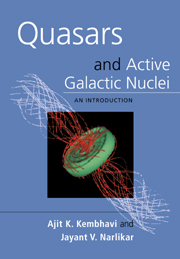Book contents
- Frontmatter
- Contents
- Preface
- Acknowledgments
- Acronyms and abbreviations
- 1 HISTORICAL BACKGROUND
- 2 THE COSMOLOGICAL FRAMEWORK
- 3 RADIATIVE PROCESSES–I
- 4 RADIATIVE PROCESSES–II
- 5 THE STANDARD MODEL
- 6 SURVEYS
- 7 LUMINOSITY FUNCTIONS
- 8 THE CONTINUUM
- 9 RADIO PROPERTIES
- 10 X-RAY EMISSION
- 11 X-RAY AND GAMMA-RAY SPECTRA
- 12 UNIFICATION
- 13 QUASAR ABSORPTION LINES
- 14 GRAVITATIONAL LENSING
- 15 PROBLEMS AND CONTROVERSIES
- References
- Books, reviews and proceedings
- Author index
- Subject index
Preface
Published online by Cambridge University Press: 05 June 2012
- Frontmatter
- Contents
- Preface
- Acknowledgments
- Acronyms and abbreviations
- 1 HISTORICAL BACKGROUND
- 2 THE COSMOLOGICAL FRAMEWORK
- 3 RADIATIVE PROCESSES–I
- 4 RADIATIVE PROCESSES–II
- 5 THE STANDARD MODEL
- 6 SURVEYS
- 7 LUMINOSITY FUNCTIONS
- 8 THE CONTINUUM
- 9 RADIO PROPERTIES
- 10 X-RAY EMISSION
- 11 X-RAY AND GAMMA-RAY SPECTRA
- 12 UNIFICATION
- 13 QUASAR ABSORPTION LINES
- 14 GRAVITATIONAL LENSING
- 15 PROBLEMS AND CONTROVERSIES
- References
- Books, reviews and proceedings
- Author index
- Subject index
Summary
The year 1963 marks a watershed in extragalactic astronomy. The optical identification of radio sources 3C 273 and 3C 48 and the measurement of their redshifts demonstrated to astronomers the existence of a new class of energy sources that have a star-like appearance, yet produce luminous energy at a rate comparable to a galaxy of a hundred billion (1011) stars.
The quasi-stellar objects (QSOs) or ‘quasars’ as these sources came to be called, arrived on astrophysicists' plates just about when they had digested the long-standing mystery of stellar energy. By the 1960s, the problems of stellar structure and evolution built on the pillars erected by Eddington, Milne, Chandrasekhar, Bethe, Lyttleton, Schwarzschild and Hoyle had been tackled successfully, thanks to the advent of fast electronic computers. The quasars, however, presented challenges of an altogether different nature. How could so much energy come with such rapid variability out of such a compact region and be distributed over such a wide range of wavelengths?
The classic book Quasi-Stellar Objects by Geoffrey and Margaret Burbidge, published in 1967, captured this early excitement and posed the numerous challenges of quasar astronomy very succinctly. Now, three decades later, we have the benefits of vast progress in the techniques of observational extragalactic astronomy and the intricate sophistication of ideas in high energy astrophysics. Yet it is fair to say that the understanding of quasars and the related field of active galactic nuclei (AGN) has not reached the same level of success that stellar studies had attained thirty years ago.
- Type
- Chapter
- Information
- Quasars and Active Galactic NucleiAn Introduction, pp. ix - xPublisher: Cambridge University PressPrint publication year: 1999



